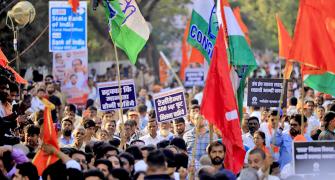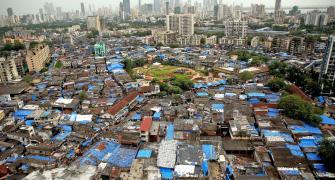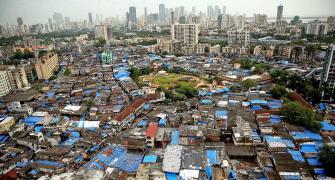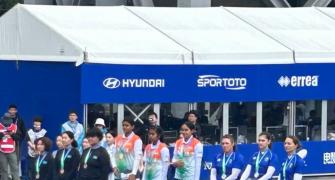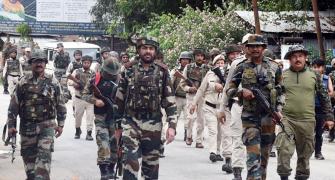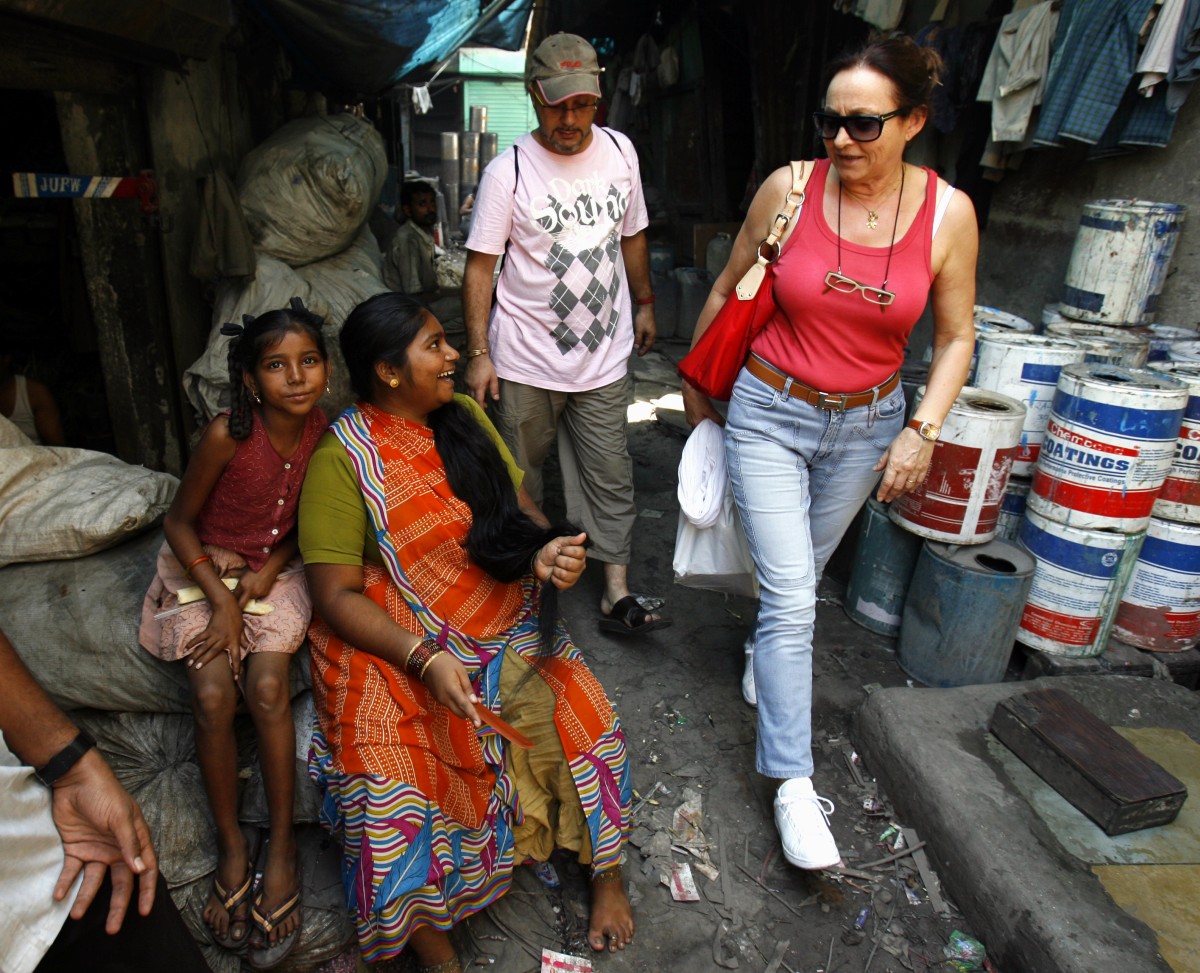'You will really wish oh! Had I stayed in Dharavi I would have got a nice house. I can assure you that. We will make dreams come true.'

Hafeez Contractor is arguably India's best-known architect.
Among his creations are the Hiranandani Gardens in Powai, north east Mumbai, the DY Patil stadium in Navi Mumbai, the Infosys campus in Pune and the DLF Cyber City in Gurugram.
He also designed 23 Marina, among Dubai's tallest residential buildings, in 2012.
Now, at the age of 73, he has taken on one of the major challenges of his life.
The Adani group, which has bagged Mumbai's biggest slum redevelopment project in Dharavi, recently appointed his firm to re-imagine the area better known as the largest slum in the country, if not all of Asia.
Spread across 2.39 square km in north central Mumbai, Dharavi is home to 300,000 people, making it one of the most densely populated areas in the world.
So, how will Hafeez Contractor change the lives of people of Dharavi with his building design?
What are his future plans for the residents of Dharavi?
Syed Firdaus Ashraf/Rediff.com spoke to the affable architect to find out.
As someone born in Mumbai, do you recall your first visit to Dharavi?
Though I was born in Mumbai, I did my schooling in Nashik. I started living in Mumbai in 1968, when I joined the field of architecture. At that time I was doing a project in the areas that were marked as mangroves and later I was designing a bus terminus project for my college, which happened to be in Dharavi.
I also recall that one of my friends' father had a tannery in Dharavi which I used to visit. I used to see the pottery works too in that area, but Dharavi has evolved from that era of Mumbai.
Did you notice the poor living conditions of the residents of Dharavi then? What did you feel about that in those days?
I can't say the living conditions were horrible in Dharavi. Because, if I get the king of Brunei to Dadar Parsi Colony where I stay (which is considered an upscale neighbourhood in north central Mumbai), he might feel that my living conditions are very poor.
I was in Dharavi a few days back and I did not see anyone over there crying or sad. Life was going on merrily. Kids were running around. Women were shopping and men were smoking at a corner.
You and I think they are in a miserable condition because we are at one level (above them), but the people in Dharavi are happy. Yes, the health conditions and hygiene need to improve.

More than an architect, you sound like a philosopher now.
This is the reality. They are happy in Dharavi. Whether they would like to improve their lives? Of course, they would like to improve their lives.
When I went to Dharavi in 1968 there were no television sets there. Now with television and so many channels, awareness has improved and therefore everyone in Dharavi wants to improve their lives. Everyone wants their children to go to better schools and colleges.
In the olden days a plumber would be very happy if his child continued in his profession, but today it is not the same case. Today, a child wants to be in a different profession than his father.
If you ask me, do the people of Dharavi need a better lifestyle? The answer is, yes. They definitely deserve it.
When the call came to you from Adani that you have to head this project, what was the first thing you told yourself?
I have been working on slum rehabilitation projects for different builders in different parts of Mumbai. I would not want to name them. I have done this kind of work for the last 20 years.
At one point of time in my career, when I was doing a study on Mumbai's Western and Central railway, I found out that there was a lot of land next to Dharavi which was railway land. It is virtually vacant with some old quarters.
I knew the economics of Dharavi and at that time I went to Piyush Goyal, who was railway minister then, stating if he could give railway land for Dharavi, then the redevelopment of Dharavi would be possible.
Piyush Goyal told me that he was a Mumbaikar and he would love to see the redevelopment of Dharavi becoming a reality. It was only later on he agreed to give this land to the Maharashtra government which changed the equation of Dharavi.
The railway land is just across the road in Dharavi and now you don't need to shift these people (from their original place during redevelopment). The process will now get faster. It was nice of the Adani group to call me and give me this job. I always wanted to do the redevelopment of Dharavi.
Video below: 'I always wanted to do the redevelopment of Dharavi'
Social housing has been my real love for so many years. My living condition will be different from some other (lower strata) person, but that does not mean that I must not try to improve the social living condition of that person.
And as a Mumbaikar and Indian I feel we have to give affordable housing to each and every citizen of this country. If we give affordable housing to every citizen of India we will become a $10 trillion economy.
Every Indian citizen must have a toilet and a bathroom in his home.
Every Indian must have a roof over his head so that he can sleep peacefully at night during the rainy season. This is what we need for our country.
And with a population of 1.4 billion we have 35 percent of Indians living in slums today.
When we achieve affordable housing for every Indian, then you can just imagine the power of our country. We talk of infrastructure, road and power but the mother of infrastructure is affordable housing for every Indian.
You are being very humane, though you went to study in the USA, the home of capitalism.
If you are a poor man's son and your father has educated you, then you must never forget the fact.
If you start earning well, then you must always take care of your parents. If you do not do that, then there is no human being worse than you.
When I went to the USA in the mid-1970s the person at the visa counter told me that I will not come back once I get my US visa. I told him, 'Sir, your country is beautiful and a rich country, but I love my country more than your country.'
The day I graduated in the USA in the afternoon, I took the same night's flight back to India. I knew had I stayed for one more day in the USA then I will never go back to India.
I love my country and now I feel it is my duty to ensure that India becomes richer than America.
We are not dumb people. We are smart people and it is just that we never had resources and right policies. Once we have the right policies we will blow everyone apart. This is my wish.
I feel each and every Indian must have an affordable house.
How was this patriotic value inculcated in you as a child?
I come from a simple background. I was born in Mumbai, but stayed in my initial days in Navsari, Gujarat. I have seen normal people honour everyone and respect everyone. I always had it that I must come back to my country.
Today, we are talking of India achieving $5 trillion economy but in those days when I came back to India in the '70s such talk was unheard of.
I feel I would love that day when an Indian who has settled in the USA by becoming the CEO of a big company decides to move back to India. It is this day I am looking forward to in life.
Who were your ideals growing up?
I had a simple life and I followed my parents. Yes, my school upbringing was very good. We had rich and poor men's children coming to the same school. We lived together and ate together in the Boys' Town School in Nashik.
There are 58,000 families and 13,000 factories in Dharavi. What kind of homes do you have in mind for them?
The kind of homes we give will be as per tenders. I can assure you now, though, that once the houses are given to Dharavi residents, they will have houses which will be definitely be better than the houses in which you and I live.
We are taking that kind of care as each house will have proper sunlight and proper ventilation.
Fellows who have shops will be given proper shops in the redeveloped project.
Today there is no proper sanitation in Dharavi but after the project everyone will have proper sanitation. Garbage disposal and things like that, everything will be worked out. And it is getting worked out.

Is it possible to give sunlight and ventilation in homes which won't be more than 300 square feet?
I am not saying anything in terms of square foot area of homes. We are giving (each house) two toilets and proper ventilation. Proper place for kids to play, then schools and balwadis, everything has been thought of carefully.
You will really wish oh! Had I stayed in Dharavi I would have got a nice house. I can assure you that. We will make dreams come true.
What about the sale component flats of Dharavi?
I don't know about this right now. First let us take the first step and the most important thing, that is how fast we will re-house them and how well we will re-house them.
Do you actually believe that in the future people will say I wish I lived in Dharavi? Who will come to stay in Dharavi?
Right now we are only talking about the people living in Dharavi and homes for them. The people living in Dharavi will be re-housed. They will be re-housed in such a nice way that the outsiders will wish they were in their place.
Video below: 'People will wish they had stayed in Dharavi'
Is there any square feet area norm per house?
It will all be in the tender and whatever is decided, we will go by that. Area is not important, but how well you give that area is important.
Politics is also taking place as organisations like the Dharavi Bachao Andolan say that they want 500 square feet flats rather than 400 square feet flats that is decided by the Adani group.
I am not into politics. I am a simple architect. And we will concentrate on our work. We will see that the people for whom we are designing are happy and the people who are going to stay are happy.
How are you adjusting your time for Dharavi's redevelopment into your busy schedule?
If you have five Dharavis, I can tackle it.
If you know what you want to do, you take two hours to design or two minutes or two days or two months of your time to design.
There is something in my mind for Dharavi and there is a big team working on it.
We will make Dharavi a success story.
Everyone all over the world will see Dharavi and say, 'Wow!'
Dharavi will be a piece of art and I will ensure it (the redevelopment project) is a success story.

